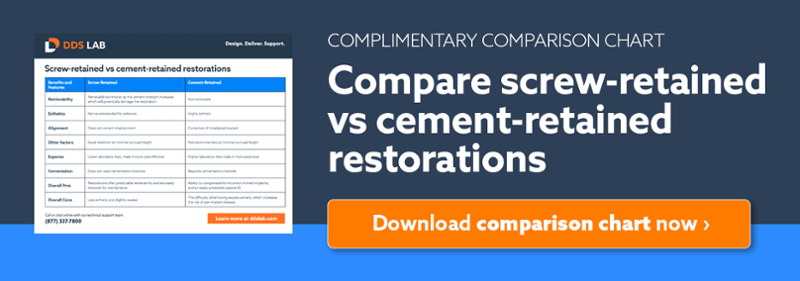Screw-retained and cement-retained restorations each have specific qualities. Your choice of which restoration will best suit the patient depends on several factors.
Retrievability
Screw-Retained Restorations
A screw-retained implant restoration offer more predictable retrievability. The restoration is usually easily recoverable and can be removed without incurring any damage. If the restoration loosens or fractures, it can simply be removed for replacement. The restoration may be retrieved to assess the surrounding tissues, to replace screws, and for cleaning. Some clinicians prefer to take a preventative approach, which includes yearly cleanings and screw replacements. Easy retrievability is especially important for long-span or full-arch bridges and may at least partly dictate the choice of restoration for the patient.
Cement-Retained Restorations
Retrievability isn’t usually possible for cement retained restorations. When a cement-retained restoration is retrievable, the process is trickier as the cement strength increases which can potentially damage the restoration beyond repair.
Esthetics
Screw-Retained Restorations
Esthetics can affect the design of screw-retained implant restorations and they are not recommended for anterior teeth. If an anterior screw-retained crown were to be placed, the the screw emergence would be situated in the cingulum area, compromising esthetics and creating a design that could be tricky for the patient to keep clean. When restoring a posterior tooth, the access hole in a screw-retained restoration is through the central fossa, affecting the cosmetic appearance of the crown.
Cement-Retained Restorations
Cement-retained implant restorations are highly esthetic, eliminating screw access holes which can be difficult to hide entirely. When choosing a cement-retained restoration, it’s possible to use an angulated abutment, creating a more natural emergence profile. A cement-retained crown allows occlusal forces to be evenly distributed along the axial inclination.
Retention
Cement-Retained Restorations
Factors affecting cement-retained implant restorations include the height of the abutment. Cement-retained restorations are not recommended at minimal occlusal height as retention may be inadequate, and a screw-retained prosthesis may be more appropriate.
Screw-Retained Restorations
Screw-retained restorations offer good retention at minimal occlusal height. A screw-retained restoration has a low-profile abutment, which may be advantageous in certain situations, as when using a bar retained overdenture. This allows for thicker acrylic and creates more room for denture teeth.
Potential Complications
Cement-Retained Restorations
Cement-retained restorations can provide slightly superior esthetics, but present one potential problem:excess cement. Chairside cementation is required and it can be tricky to ensure all excess cement is removed. When excess cement remains, it increases the risk of tissue damage, which can then leading to chronic inflammation and bone loss through peri-implant disease. The soft tissues surrounding screw-retained implant restorations tend to be healthier than soft tissues surrounding cement-retained restorations. One potential solution is to provide the patient with a custom abutment, designed with tissue level or supragingival margins, to allow for easy cement removal. This solution is not recommended for anterior cases.
Screw-Retained Restorations
Screw-retained restorations can develop complications caused by porcelain fractures or loosened screws.The cyclical loading action of chewing food can loosen screws and cause fatigue fractures in the prosthetic screws. This is more of a risk in single posterior restorations. Using a ratchet wrench to create the recommended torque greatly reduces the risk of this complication. In general, occlusal surfaces are more prone to fracturing on screw-retained restorations because they are slightly weaker. Screw-retained restorations may be more likely to develop porcelain fractures around the screw access hole.
Other Factors That Must Be Considered
Reducing Stress to the Bone and Implant
When placing dental implants, you’ll want to reduce stress to the bone and the implant as much as possible. This is done by ensuring a passive fit of the restoration on the abutment. CAD/CAM technology also compensates for distortions, allowing the cement space to be adjusted accordingly.
Cost and Accessibility
A cement-retained crown can be less cost-effective as laboratory fees are higher. In comparison, laboratory fees for screw-retained restorations are lower and treatment is more cost-effective.
When restoring a posterior tooth, it’s challenging to fit a screw-retained restoration in a patient who is unable to open their mouth widely enough. A cement-retained restoration may be a more desirable choice where occlusal access is limited. Alternatively, an angulated screw channel solution could be appropriate depending on the implant system chosen.
Weighing the Pros and Cons
Cement-retained crowns are the most commonly used restoration in dental implantology. This is because it is possible to compensate for incorrectly inclined implants, and it is easier to achieve a passive fit. An intact occlusal surface and lack of a screw access hole make it easier to control occlusion. A major disadvantage of cement-retained crowns is the difficulty removing excess cement, which increases the risk of peri-implant disease. In contrast, screw-retained restorations offer predictable retrievability. They can easily be removed for maintenance or repairs or if surgical interventions are needed. However, it isn’t possible to correct a misaligned dental implant with a screw-retained restoration. Angulated screw channels are available for some implant systems.
Both types of restorations have similar success rates that are largely dependent on the forces and stresses applied to the implant and bone. Improved implant components provide greater predictability and stability for cement-retained and screw-retained restorations. For clinicians who feel comfortable in their technique for successfully removing all excess cement, the main considerations are more likely to be esthetic.
Please be reminded that should you wish to discuss a case in more detail, our experienced technical team is here to assist you.
Click here to schedule a consultation with our technical team »
